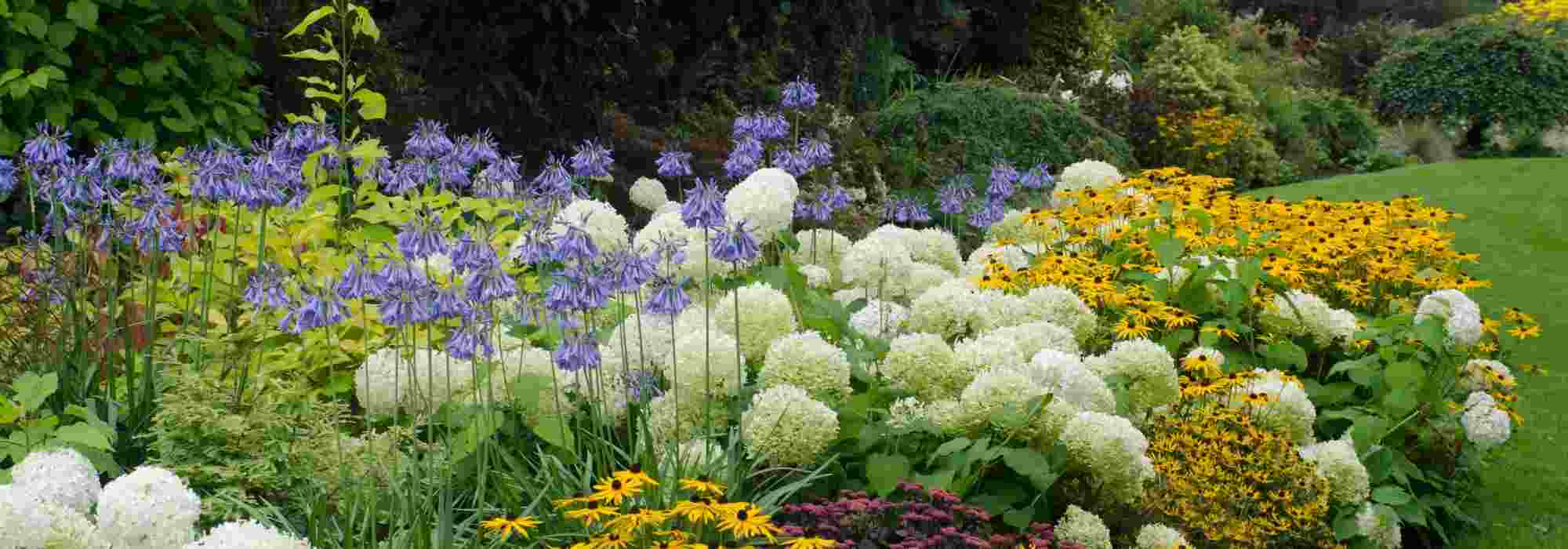
Pairing White Flowers
How to combine white in the garden?
Contents
White flowers bring brightness, softness, elegance, and a lot of cohesion to flower beds or pots on the terrace. Whether it’s perennial plants, bulbous plants, or flowering bushes, focusing on the colour white promises a refined and relaxing atmosphere, equally at home in romantic gardens or contemporary gardens.
Let’s explore how to effectively combine this neutral colour in the garden, with which colours, which foliage, in different atmospheres, and which shades to favour according to the desired ambiance?
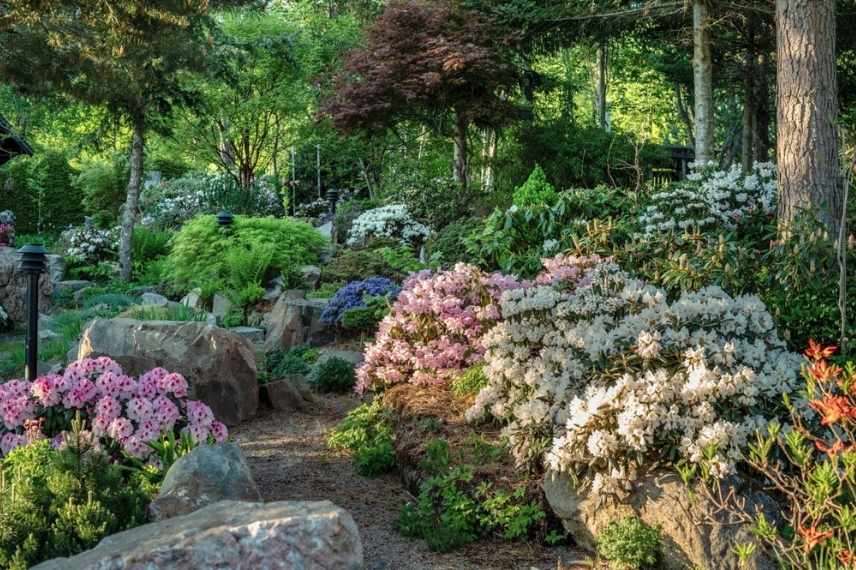
White flowering azaleas brighten up shaded areas of a garden
About White
- 50 shades of white… or almost, as it is true that there is not just one white but many shades ranging from pure white to pinkish whites, greenish whites, cream whites to bluish whites, very pale yellows that appear white, and speckled or striated whites. There are also white flowers enhanced by a very colourful heart from their stamens, and many marginated or variegated flowers in a bicolour style. In short, white is multiple, and whatever its variation, it always conveys a poetic and refreshing note in a garden.
- When combined with other colours, white flowers vary in intensity and lighten the overall effect.
- White flowers are very useful for creating connections, fostering a sense of harmony: it is a colour that acts as a bridge and transition between plants.
- The white of flowering plants gives an immediate brightness to shaded areas.
- White, the quintessential neutral shade, allows for stunning displays with flower colours that are often chosen to be soft, even powdery, to create pastel effects and a calming atmosphere or, conversely, in contrast with saturated and deep shades like blue.
- Beware: white flowers capture the eye. While they highlight the plants and accentuate the surrounding furniture, their presence must be carefully balanced.
 The brilliant white of Veronicastrums serves to showcase other colours, enhancing the deep blue of the background.
The brilliant white of Veronicastrums serves to showcase other colours, enhancing the deep blue of the background.
Associating white flowers in a monochrome garden
Let’s start with the simplest on paper, the association of white flowerings in a white garden.
We discuss this in more detail in the design of a monochrome white garden: while it is very refined, the white garden does not rely on the same flowerings depending on whether it is an urban garden, a naturalist garden, or a country garden. Depending on the environments, it is necessary to play with volumes and inflorescences that are more or less airy or downright sophisticated and graphic.

For example, in this scene, the verticality of the Eremerus (in the centre) energises the whole: Choisya ‘Aztec Pearl’, Philadelphus arching, Lonicera nitida, and Agapanthus
In other monochrome gardens, particularly the blue garden and the yellow garden, white excels at distilling here and there, as punctuation in the beds, this incomparable binding effect. White flowers ultimately have the gift of highlighting the other dominant colour of the monochrome garden. They also prevent the monotony that would arise from using these two strong colours, cold for blue and very vibrant for yellow, in a single mode.
Discover other White flowering perennials
View all →Available in 0 sizes
Available in 1 sizes
Available in 1 sizes

Available in 1 sizes
Available in 1 sizes
Available in 1 sizes
Available in 2 sizes
Available in 1 sizes
Available in 1 sizes
Available in 1 sizes
Pairing white flowers with other colours
Several colours pair well with white, particularly blue and yellow, but also pink and peach shades, and… green. For the first two colours, it’s really a matter of dosage and proportions that must be respected, so that none of the flowers overshadow the others, while always keeping in mind a principle of harmony, in colour gradients.
When deciding to pair white flowers with other shades, it can be done in certain bicolour beds for very contemporary and chic atmospheres, or in scattered splashes of colour to create more abundant scenes:
White Flowering in Duos
- With blue: It is always interesting to spice up colours close to blue on the colour wheel, from violet to purple, up to very dark blues and blacks. White flowers placed in front of blue blooms enhance the depth effect that blue colour provides. In a contemporary garden, one can dare to combine whites with very vivid and deep blues, which gives a lot of character and a pronounced duality, reinforced by furniture with clean lines, and upright or graphic bush habits.
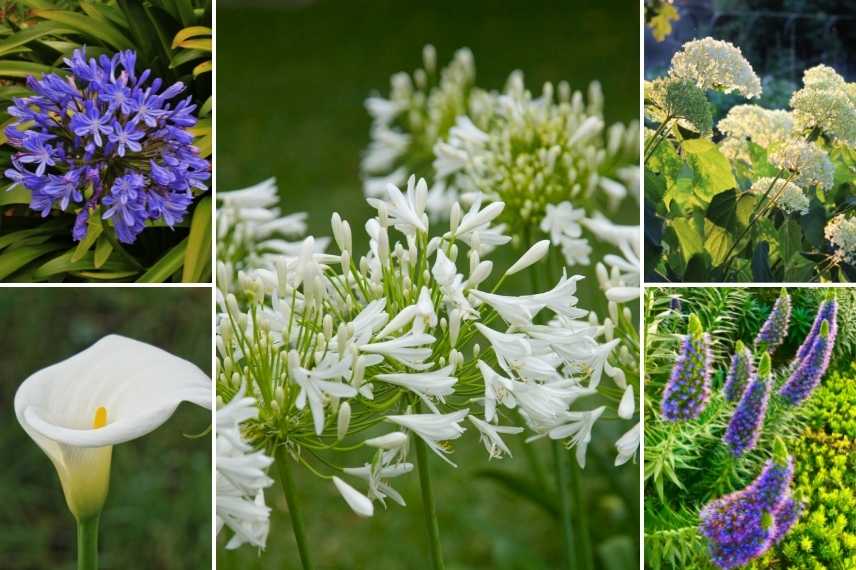 Blue and white Agapanthus, Arum, ‘Annabelle’ Hydrangeas, and Canary Viper’s Bugloss
Blue and white Agapanthus, Arum, ‘Annabelle’ Hydrangeas, and Canary Viper’s Bugloss
- With pink: The combination of white and pink flowers is graceful, almost obvious, and rarely suffers from bad taste. It is interesting for romantic décors, cottage or country gardens to mix bicolour white blooms to perfect the very soft harmony of these scenes. However, be careful to avoid a sugary or mawkish look: adding aniseed, purple, or greyish foliage is useful to add more rhythm to these pastel shades.
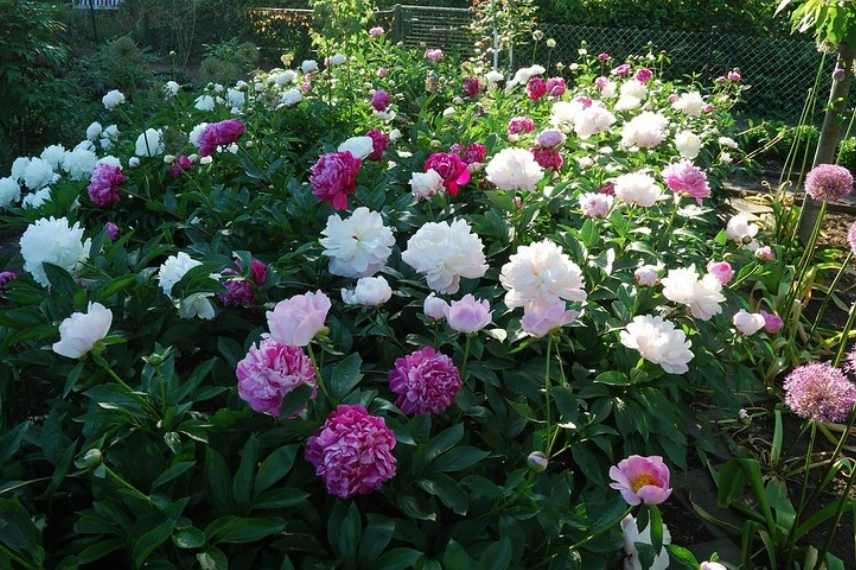 A duo of white and pink peonies © Ting Chen
A duo of white and pink peonies © Ting Chen
- With yellow: or rather yellows, from very pale to golden, even orangey for a dynamic décor as white reveals the warmest yellow tones. These are particularly spring-like scenes that excel in this colour combination.
 A very soft décor of white Leucanthemums, lupins, and Iris, punctuated by the green of a Pinus mugo © Mark
A very soft décor of white Leucanthemums, lupins, and Iris, punctuated by the green of a Pinus mugo © Mark
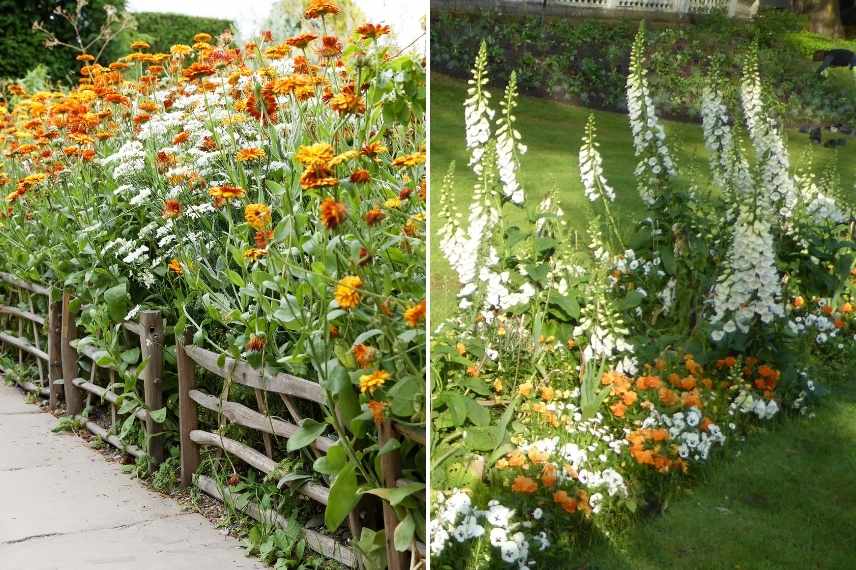 On the left, a white splash relieves the orange mass of marigolds; on the right, a larger proportion of white flowers brought by foxgloves and pansies: only a few wallflowers pleasantly punctuate the whole © Gwenaëlle David
On the left, a white splash relieves the orange mass of marigolds; on the right, a larger proportion of white flowers brought by foxgloves and pansies: only a few wallflowers pleasantly punctuate the whole © Gwenaëlle David
- With green! Yes, some green flowers pair perfectly with the virginal white of perennial flowers or with the cream shades that many white flowers display. By introducing plenty of foliage, this fresh combination is ideal for city gardens and in all semi-shaded gardens that gain in brightness.
 A beautiful summer scene in warm tones of yellow, pink, and mauve, brightened by the whiteness of a Buddleia and white Phlox
A beautiful summer scene in warm tones of yellow, pink, and mauve, brightened by the whiteness of a Buddleia and white Phlox
Pairing white flowers with foliage
Touches of pure white flowers in a sea of greens create an elegant and easy-to-use alchemy. One should primarily choose evergreen foliage, medium to light greens, even silvery to bring softness. Greyish foliage will be particularly useful in very sunny areas, but it will need to be complemented with some more contrasting foliage to highlight the white inflorescences and avoid glare caused by too much sun.
The harmony of white flowers with foliage is particularly beautiful in shaded to semi-shaded areas where one can find a wealth of white to cream flowering plants: Japanese Anemones, Astilbes, Thalictrums, Omphalodes, Tiarellas, Hellebores, etc. In this configuration, opt for broad foliage (Acanthus, hostas, Dryopteris, Farfugiums…).
Sunny exposure is the other bright and radiant option, featuring aesthetic flowers such as: Alliums and Agapanthes, Delphiniums, Hydrangeas paniculata, Iris, Arums, Lilies… They too are enhanced by graphic or structural foliage (Yucca rostrata, Phormiums, Santolines, Pittosporums, Hebes, Fescues…). Some purple foliage can also rhythm a bed of white flowering plants: Physocarpus or Cordyline australis ‘Red Star’ for example.
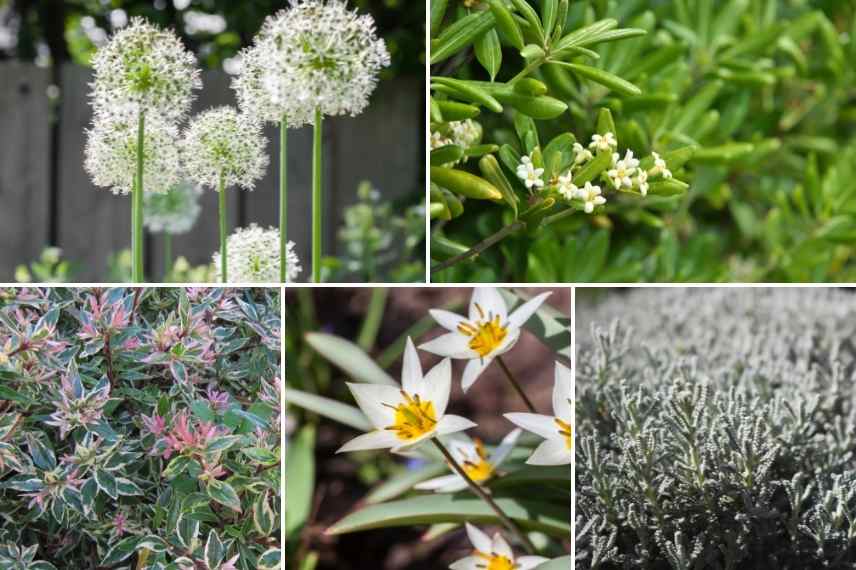
White Alliums, Pittosporum tobira, Abelia grandiflora ‘Confetti’, Tulipa turkmenista, Santolina chamaecyparissus
Pairing White Flowers to Match Your Garden Style
White flowers harmonise beautifully in various garden styles, depending on the chosen varieties, from roses to heathers, from Japanese-style bushes to exotic plants:
The Contemporary Garden
Elevated in a design garden, white flowers often play an architectural role. They excel in a white garden, superbly highlighted by contrasts of dark or light foliage from grasses, as well as violet-blue flowers. For these settings, opt for graphic upright habits such as Eremerus, Veronicastrums, Arums, and round inflorescences like Agapanthus, Hydrangeas Annabelle, Echinops ritro, and Alliums. In terms of foliage, try combining silver tones or bring in clean, dynamic lines with horsetails, Phormiums or Cordylines, the rounded forms of Pittosporums or boxwoods, a palm, or a Cyathea dealbata for an exotic touch, or the grey foliage of a Pyrus salicifolia ‘Pendula’. In a minimalist style, reduce this plant palette to tufts of stipas or fescues, or even vertical Panicums.

The Naturalistic Garden
This is another setting well-suited to white flowers, chosen for their soft habits and wild appearance, such as Cosmos, mulleins, Veronicastrums, scabious, or for example, echinaceas and achilleas reinforcing the meadow image. The advantage of these perennial plants is that they come in several colours, from pinks and mauves to oranges, and it is very harmonious to mix them together. This sunny garden benefits from integrating other more vibrant wild plants or a multi-coloured approach for a very natural effect: Leucanthemums, Sanguisorbas, Heleniums. You can also incorporate Pennisetums with cream inflorescences that add softness and cohesion with the white, or airy Molinies.

Leucanthemums, Sanguisorbas, Verbascum, Purple Echinaceas, Achilleas, Molinie and Cephalaria.
The English Garden
White flowers blend perfectly into a bucolic atmosphere where shades of pink and blue merge in abundance within opulent mixed borders, whether serene or vibrant, inviting orange to red tones. The flowers are stunning when combined in varied shades: pink peonies and white peonies, purple and white wisterias, yellow and white roses, bicolour clematis, etc. For this type of romantic garden, favour white inflorescences in panicles, umbels, and spikes, along with soft-habited plants like salvias, Phlox, Gauras, etc.
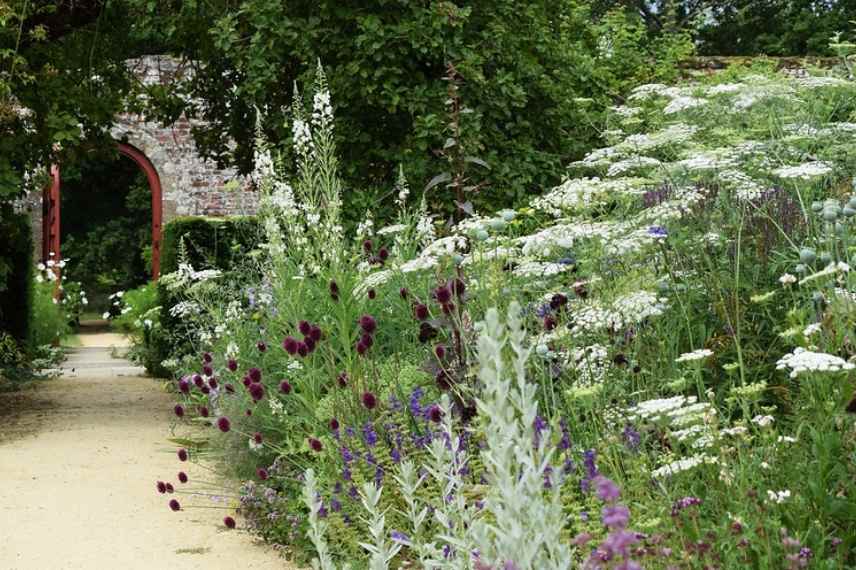
An English garden playing solely on white, grey, and mauve tones (© Mark)
The Exotic Garden
It is possible to incorporate atypical inflorescence shapes, such as Arums, the ‘Constance Elliott’ passionflower, acanthus, Roscoea beesiania ‘Alba’, Yucca, and banana plants, and in mild climates, tropical-looking flowers like Brugmansia, jasmine (Jasminum multipartum), Ismene festalis or spider lily, and Crinums. Incorporate bicolour white flowers tinged with yellow or variegated with warm shades: Alstroemeria ‘Garden Summer Sky’, Plumaria, Tricyrtis, Tigridia ‘Alba’, Crinum ‘Striped Beauty’, Hibiscus syriacus ‘French Point’, etc. For this lush garden, also compose with just one or two solid-coloured plants to punctuate and enhance the exoticism of the scene: a pink hibiscus, an Hedychium in orange, or purple Eucomis, and infuse plenty of greenery with bamboo ferns, tree ferns, and XXL foliage, etc.
 Brugmansia, Cythaea, Alstroemeria ‘Garden Summer Sky’, frangipani, Hibiscus coccineus, Hibiscus syriacus and banana plant
Brugmansia, Cythaea, Alstroemeria ‘Garden Summer Sky’, frangipani, Hibiscus coccineus, Hibiscus syriacus and banana plant
The Japanese Garden
Delicate white flowers fit perfectly into a Japanese-style garden, bringing their extreme delicacy: azaleas and rhododendrons, Pieris, Magnolias stellata, as well as perennials like Solomon’s seal… Choose them in white to cream, with subtle shades of pink like Rhododendron edgeworthii and Pieris polifolia ‘Blue Ice’. Here again, one or two pinkish shrubs will support the whole, such as Prunus incisa ‘Mikinori’. Cream-variegated foliage like Cornus controversa or a tabular silhouette like Viburnum plicatum, the purple leaves of Japanese maples, cloud-pruned conifers, and Japanese groundcover grasses (Ophiopogons black and Hakonechloas gold) will be essential companions.
 Prunus incisa ‘Mikinori’, Acer ‘Garnet’, Magnolia, Fatsia japonica, Rhododendron, Polygonatum, Kalmia latifolia
Prunus incisa ‘Mikinori’, Acer ‘Garnet’, Magnolia, Fatsia japonica, Rhododendron, Polygonatum, Kalmia latifolia
Associating white flowers with different seasons
Spring
Spring, a vibrant season, is bursting with white, blue, and pink blooms, found among bulbous plants (daffodils, muscaris, wood anemones, Scillas…) and many shrubs (Magnolias, azaleas, and viburnums leading the way). The white-blue-pink trio is magical, just like the freshness of the yellow and white combination (to be paired with daffodils, for example), but you can also add pale yellow and greenish notes to create more vibrant scenes with the help of Euphorbia characias.
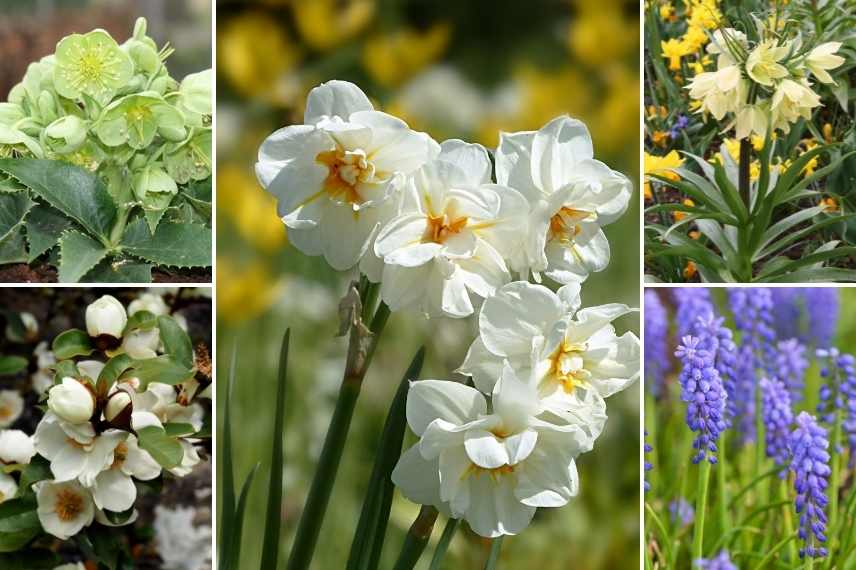
In spring, white blooms pair beautifully with green, yellow, and blue shades: Helleborus argutifolius, Michelia yunnanensis ‘Gail’s Favorite’, double-flowered daffodils, Fritillaria ‘Raddeana’, and muscaris.
Summer
White flowers are best showcased in partial shade to counteract an overly bright effect in full sun. They are perfect for accompanying vibrant shades, which they help to soothe. The choice of compositions is particularly varied in summer. You have a wealth of options, always aiming to limit the colour palette of the bed to three colours for a beautiful visual harmony.
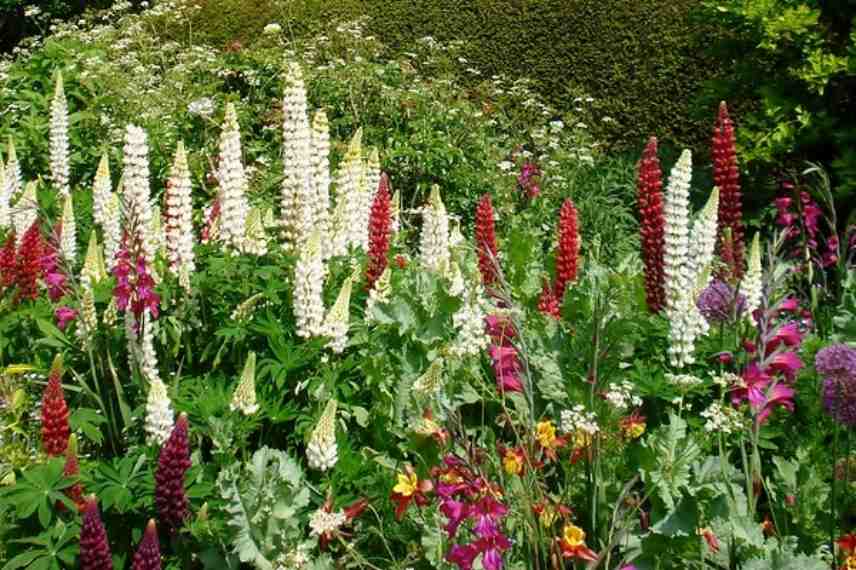
A generous bed of white and purple Russell lupins, Alliums, Columbines, and Gladiolus communis (© Phil Bartle)
Autumn
There are fewer white blooms in autumn, primarily relying on Camellia sasanqua, the strawberry tree, Abelia, the remontant Choisyas, and some late Hydrangeas that start to turn cream, along with a few roses and Heptacodium. Among the perennials, Japanese Anemones, some Asters, Eucomis automnalis, Cimicifugas, Gladiolus callianthus, and Liriope offer beautiful white notes in autumn. With deciduous foliage starting to blaze, blue and apricot combinations will be stunning to accompany these last white flowers such as Chrysanthemums ‘Herbstbrokat’ in lovely apricot shades, Sedums ‘Orange Xenox’ with purple foliage, Asters cordifolius ‘Blue Heaven’, Dahlias ‘Babylon Bronze’ still in shape, or vibrant Epilobiums canum. Also consider a few grasses at the peak of their beauty: Miscanthus in golden hues or Schizachyrium in blue tones!
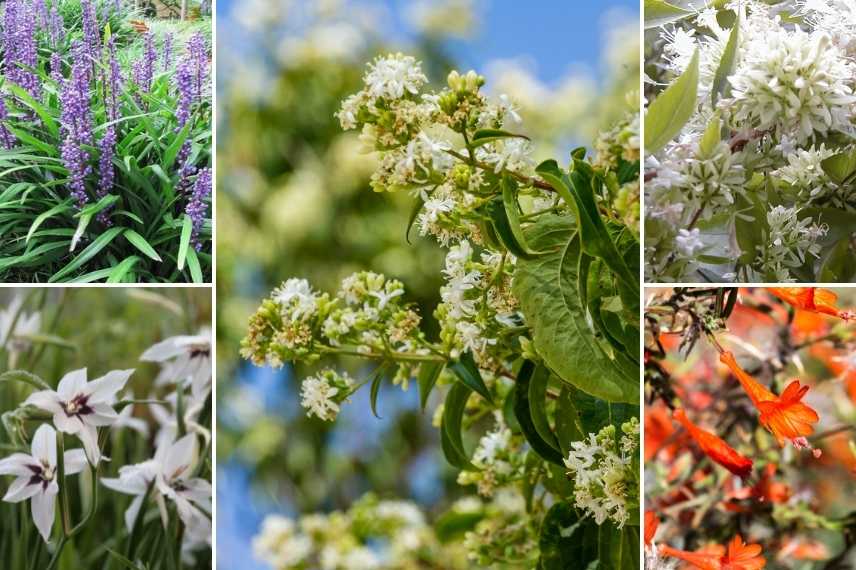
Liriope muscari ‘Majestic’, Gladiolus callianthus, Heptacodium miconoides, Abelia chinensis, and the orange Epilobium canum
Winter
White flowers in the cold season possess an incomparable poetry, but with often grey and low skies, it is essential to brighten the whiteness of the few shrubs or perennials as much as possible. It is interesting to offer a wider sample of varied colours around white and to plant long-lasting white blooms such as heathers and hellebores. In winter, we focus on vibrant combinations with yellow to orange tones thanks to a few winter kings: Mahonia, Hamamelis, Cornus mas, Chimonanthus praecox, and Edgeworthia that will take turns. Beds composed for winter with hellebores and white heathers also benefit from pink, purple, or apricot tones (the stunning Viburnum bodnantense, Japanese quinces, Daphne mezereum,…) as well as the decorative wood of dogwoods and the sparkling whiteness of birches. You can perfectly combine white, yellow, and mauve or purple to awaken the garden and gently invite spring!
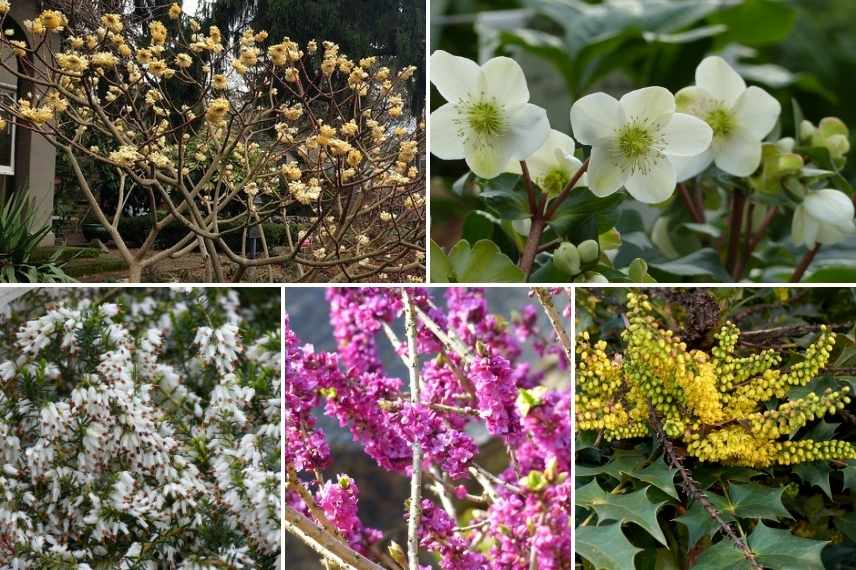
Edgeworthia chrysantha with white and yellow flowers, Hellebore ‘Candy Love’, white Heather (Erica carnea ‘Springwood White’), Daphne mezereum, and Mahonia
- Subscribe!
- Contents

































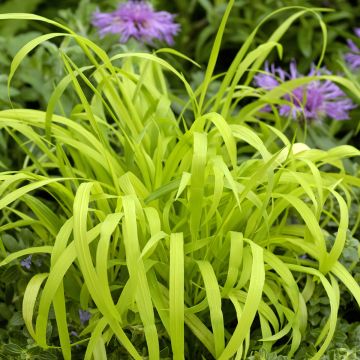
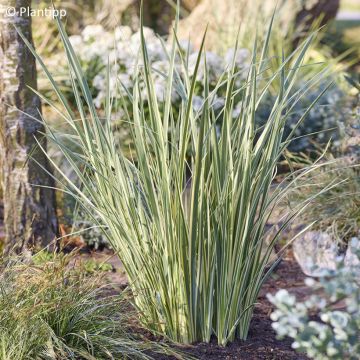
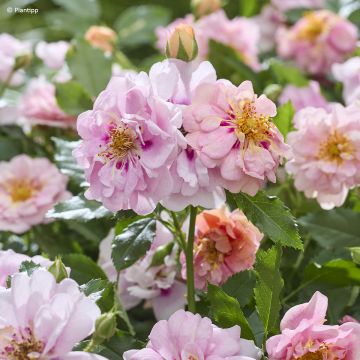
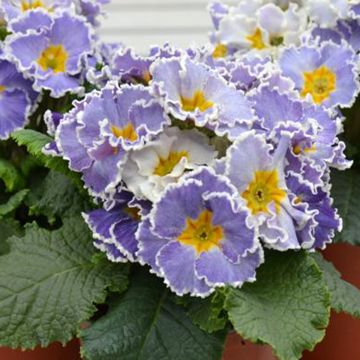
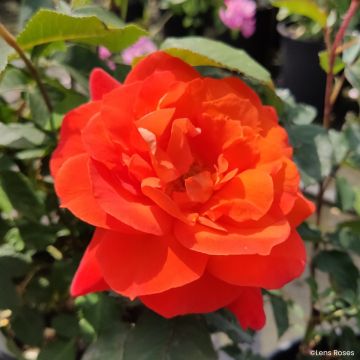
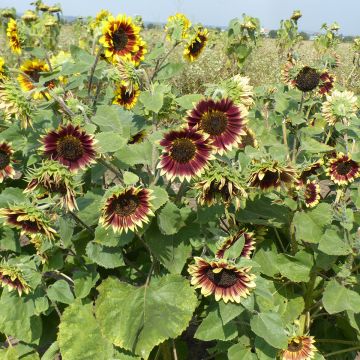
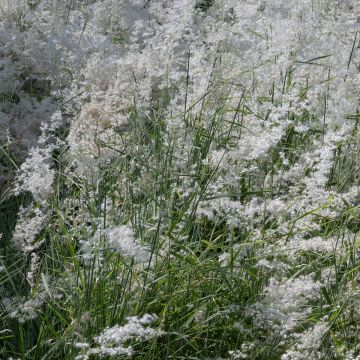
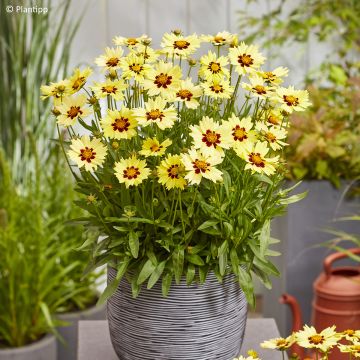
Comments